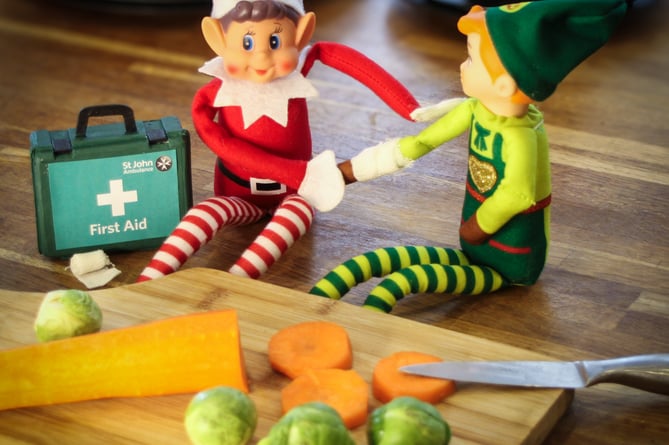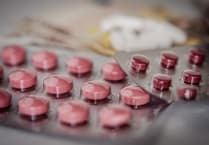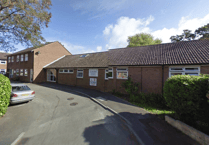It’s beginning to look a lot like Christmas…. and to ensure a safe and healthy festive season, St John Ambulance is sharing a sack full of first aid advice to prevent accidents spoiling the celebrations. The national health response and first aid charity is also urging everyone to ‘slow down’, as preventable mishaps often happen when we are rushing around.
St John Ambulance's Medical Director, Lynn Thomas, said: “The festive period is almost here and is a joyful time, but we’ve wrapped up a gift box of first aid techniques for you so you can cope easily with anything that might go wrong …the DIY decorations, hordes of people under one roof, excessive eating and drinking, and new toys and gadgets to choke on or trip over.
She added: “It is well known that many accidents happen in the home and, unfortunately, at this time of year it is often the young and elderly who are at increased risk of a Christmas first aid incident especially with choking on finger foods or children putting small toy pieces in mouths. We’re encouraging people to learn a few basic first aid skills so that families can look after themselves at home at a time when hospital emergency departments and ambulance crews will be working very hard. We hope our first aid tips will get people up to speed before the festivities begin and help them avoid jollity turning into A&E.”
Get a handle on candles:
Christmas is the time of year most fire related incidents happen, with Government figures showing candle fires account for around 4% of fires and 4% of deaths every year.* Additionally, with the current energy crisis, there is evidence to suggest that candle use will increase, therefore putting you and your family at greater risk of a fire.
- Candles – don’t leave them unattended and do blow them out before you go to bed.
- Make sure they are in suitable non-plastic holders/containers and keep away from any decorations/cards/curtains.
- Keep candles, heaters and fires away from Christmas cards, wrapping paper and decorations.
- If you have small children or elderly guests – consider LED candles instead.
What to do if you do get a burn:
- Move the person away from the heat and danger
- Start cooling the injury as soon as possible. Place the burn or scald under cool water for 20 minutes minimum or until the pain goes away.
- If the burn is deep, or larger than the person’s hand, on their face, hands, feet, intimate area or the casualty is a child - call 999 immediately.
- Remove jewellery and clothing around the area, unless stuck to the burn.
- Cover the burn loosely, lengthways with kitchen film to help prevent infection and keep it clean.
- Don’t burst blisters.
- Monitor and treat for shock if necessary.
Smoke inhalation:
- Move them away from the smoke so they can breathe in some fresh air.
- Help them sit down in a comfortable position and loosen any tight clothing around their neck to help them breathe normally.
- If they don’t recover quickly, call 999 for an ambulance or 112 for urgent medical advice. Keep them calm whilst they are waiting.
Deck the halls – but avoid the falls:
Nobody has Christmas crutches on their wish list if it can be avoided, so follow these simple tips…
- Take your time putting up decorations – rushing can lead to trips, falls and sprains.
- Don’t go up to the loft to retrieve tinsel and baubles alone - get some help from a family member, friend, or neighbour.
- Don’t cut corners by standing on chair or stools, and if you have a stepladder – use it.
What to do if you fall:
Look out for pain and tenderness, swelling and bruising and difficulty moving the area, especially if it’s a joint.
R – Rest the injured part. Help them to sit or lie down.
I - Apply an ice pack or cold compress such as frozen peas wrapped in a tea towel for around 20 minutes.
C – Comfortable support. Use blankets, cushions to support the injury.
E – Elevate the injured part.
Scary fairy lights:
De-tangling fairy lights scores high on the festive stress test and is not much fun, but neither is getting a shock from lights on the blink…
- Once you’ve untangled them check for damaged or frayed cables – and if you do find any damage, it’s better to be safe than sorry, so recycle them and stick to tinsel, or buy a new set.
- Check they work before putting up and if you do have a real Christmas tree, always unplug lights before watering the tree to reduce the risk of electric shocks.
- Double check any exterior lights are safe and designed for outdoor use and keep plugs/transformers indoors.
What to do if you do get an electric shock, burn, or someone goes into cardiac arrest:
- Move the person away from the electrical source. You may be able to stand on some dry insulating material (such as a plastic mat or wooden box) and use a broom handle or wooden pole to push the casualty's hand or foot away from the source.
- If it’s not possible to break contact using a wooden object, loop some rope around the underneath of the casualty’s arms or ankles and pull them away from the electrical source.
- Do not touch the casualty until they are clear of electrical source.
- Once you’re sure the contact has been broken between the casualty and the electrical source, perform a primary survey - https://www.sja.org.uk/get-advice/first-aid-advice/how-to/how-to-do-the-primary-survey/ - and treat any injuries.
Hell’s Kitchen!
Feeding a horde of relatives and friends can be stressful…. Prepping as much as you can in advance (i.e., the night before) saves time as you will have a clear idea of cooking times for everything, and a volunteer or two with set tasks such as plating up starters, laying the table, or helping to clear away!
- Knife injuries – be careful when preparing vegetables and carving the meats to avoid cuts.
- Food poisoning – in the stress of serving up Christmas dinner on time, corners may be cut. Make sure you allow plenty of time to cook your bird and stuffing.
- Singed eyebrows #notagoodlook - don’t walk and talk with a flaming Christmas pud! Instead set light to it on a safe counter, away from little ones, or on the festive table.
- Allergies – remind guests to let you know if they have allergies and if you have one yourself ensure you have antihistamines in your cupboard and carry your epi pen for a more serious allergic reaction called anaphylaxis.
What to do if you cut yourself:
- Clean the wound by rinsing it under running water or using sterile wipes.
- Pat the wound dry using a gauze swab and cover it with sterile gauze.
- Remove the cloth or gauze covering the wound and apply a sterile dressing or a large plaster.
Seek medical help if:
- a wound won’t stop bleeding.
- a foreign object is embedded in the wound – like a splinter of wood or glass.
- the wound is from a human or animal bite.
- you think the wound might be infected.
- you are unsure whether the casualty has been immunised against tetanus.
What to do if you suspect anaphylactic shock:
- Call 999/112 for help and tell them you suspect anaphylactic shock.
- If the casualty has an adrenaline auto-injector (epi pen) help them to use it.
- Pull off the safety cap and holding it with your fist, push the tip firmly against the casualty’s thigh until it clicks, releasing the medication (it can be delivered through clothing).
- Hold in place for ten seconds (follow the instructions on the device), then remove.
- Help the casualty sit up, in a position that best relieves breathing difficulty. If they are pale, with a weak pulse, help them to lie down with their legs raised.
- If they have more than one EpiPen, Repeated doses of adrenaline can be given at 5-minute intervals if there is no improvement, while waiting for help to arrive.
Don’t forget to look out for more festive first aid on St John’s social media channels. You can also find a lot more free advice including videos of first aid techniques on St John’s website – www.sja.org.uk.




